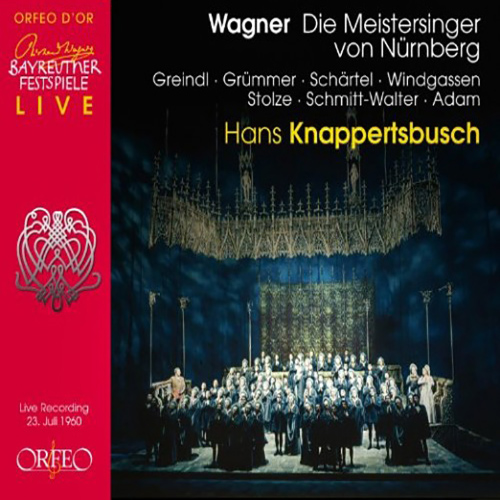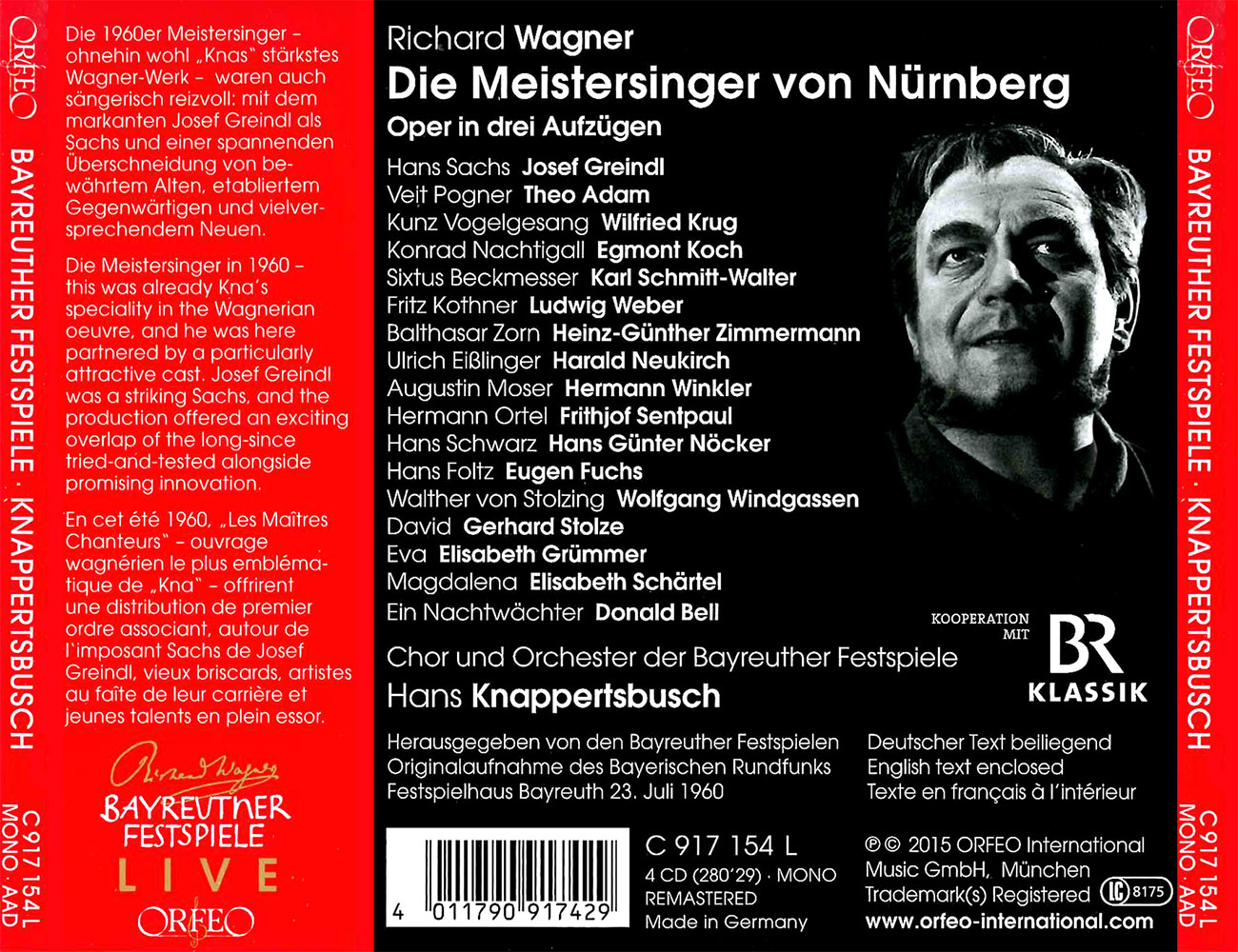WAGNER: Die Meistersinger von Nürnberg
Hans Knappertsbusch is regarded today as one of the great Wagner conductors of the past. But we should note that this great Wagnerian, born in Elberfeld in 1888, the embodiment of the old German orchestral tradition, did not enjoy success at Bayreuth until after the Second World War – in fact, it was only after the War that he made his debut there. The paths of history can be tortuous indeed. In this Wagnerian realm, “Kna”, as he was known, conducted a dramatic Flying Dutchman in 1955 (available on ORFEO 692092) but primarily devoted himself to the great, “heavy”, later works, namely the Ring of the Nibelung (660 513), The Mastersingers of Nuremberg and Parsifal (690 074). Besides his Ring cycles of 1956-1958, Kna was probably most famous for his Parsifal; until his death 50 years ago, there was only one year when he did not conduct it (the performance on the ORFEO label is his last, from 1964). It was also his Parsifal that truly set the standards for others to follow, and that had a long-lasting impact. And yet, despite the man’s supposedly so deeply serious nature, many a Knappertsbusch connoisseur finds even more qualities to admire in his interpretation of Wagner’s “grand comic opera” The Mastersingers, his longest single work. Or perhaps we should express this differently: that greater justice is done to this work through him. Kna in fact repeatedly displayed his joy in the lighter muse – from the Badner Madl’n by Komzak to the Merry Wives of Windsor by Nicolai, the complete recording of which only surfaced a few years ago (ORFEO 787 102).
Kna’s Mastersingers lives from a sense of vocal collaboration that is rather untypical of Wagner performances. Here, a highly colourful ensemble offers the vital variety necessary for its characters. The 43-year-old East German guest Theo Adam is completely convincing as Veit Pogner, Eva’s father (eight years later, he sang the role of Sachs in the same venue, this time under Karl Böhm; see ORFEO 753084). But one of the highpoints of the performance is the powerful debut in the role of Sachs offered by the 47-year-old Josef Greindl. He was already well acquainted with the Mastersingers, having sung the role of Pogner on the first night of this Wieland Wagner production under André Cluytens in 1956, as he had already done under Furtwängler in Bayreuth in 1943/44 and under Fritz Reiner at the Met in 1953. Greindl’s powerful bass register was complemented by an admirably effortless mastery of the exposed baritone passages in his role, which remain effortless to the end of the evening. And yet despite his strength of voice, this is no blustery performance; instead he often achieves supple, sensitive nuances in his interpretation (and by all accounts he also possessed film-star good looks on stage). The vocal achievement of Elisabeth Grümmer (49 at the time) can only be described as superb: she sings with technical perfection, touching emotion and completely convincing youthfulness. We tend to associate Wolfgang Windgassen’s voice in these years with the much heavier heldentenor roles in Wagner, and given his audible vocal reserves his portrayal of the noble outsider von Stolzing sounds unusually serene. The nimble Karl Schmitt-Walter had been the Beckmesser of this production since 1956, and he by no means makes him merely laughable. The 33-year-old Gerhard Stolze sings David, and we can hear in his singing and his acting the rising star that he was. Together, these four men offer a flexible “male quartet” whose interactions are simply ideal – as they also are with the other voices in the opera. All in all, this is a happy mixture of proven older voices, younger voices that are just getting established, and an impressive debut in the role of Sachs.
Yet the star of the performance is undoubtedly the 72-year-old newcomer to the production, Hans Knappertsbusch. His interpretation of this complex, tricky work is anything but Teutonic and heavy, but instead consciously cultivated and restrained, always supportive of the voices, relaxed, and with a chamber-music lightness in the dialogues (which does the work good and precludes any sense of longueur). The impact of the fugue during the brawl in the second act, for example, is all the greater for it – it is performed as a great arch (and with a great sense of fun in the hubbub it makes), and the excitement lasts all the way to the end of the act. The manner in which Kna savours the dances on the festive meadow is also astonishing, displaying something between the magically twee and the gruffly rustic, all in careful doses, and conjoined with audible pleasure in the affectionately framed choral interjections that are almost dadaist in their effect. This is truly “festive”!
In contrast to a market badly marred by pirated copies and unauthorised editions, much care has been invested here in restoring the original sound. This edition is adorned once more by exclusive stills from the Bayreuth archives and a highly stimulating essay by Peter Emmerich on the dramaturgical situation in Bayreuth in 1960 and its impact on the Festival audiences.

















